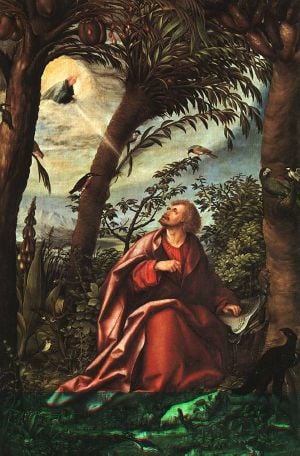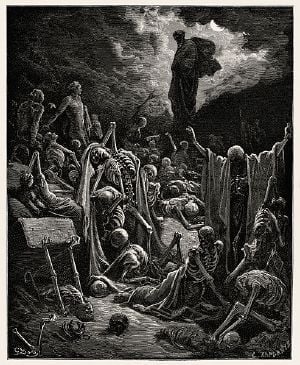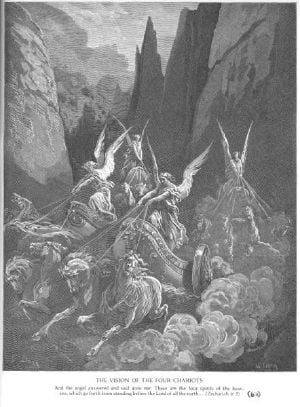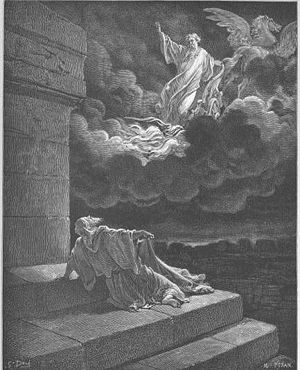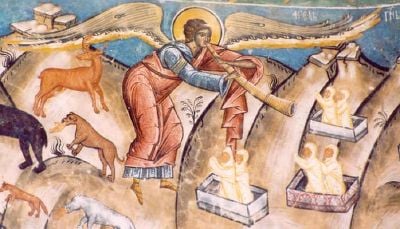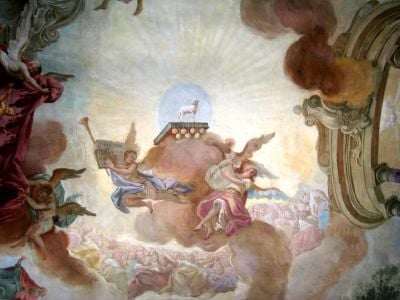Apocalyptic literature
Apocalyptic literature is a genre of prophetical writing that developed in post-exile Jewish culture and was popular among early Christians. The term "Apocalypse" is from the Greek word for "revelation" which means "an unveiling or unfolding of things not previously known."
The apocalyptic literature of Judaism and Christianity embraces a considerable period, from the centuries following the Exile in Babylon down to the close of the Middle Ages. The best known literature of this type was created in Judaism from 200 B.C.E. to 100 C.E., and in Christianity from 50 to approximately 350 C.E. Much apocalyptic literature was produced in this period, but only a small portion of it was included in either the Hebrew Bible or the New Testament.
Apocalyptic literature is written in symbolism, poetry, and imageries, as well as in an Old Testament prophetic style (See Matt. 24-25; Mark 13; Luke 21; Rev. 1:2-4; 19:9; 22:7-19). In larger works, such forms are woven as a tapestry to describe events in cataclysmic terms, such as in the Book of Daniel and most of all the Revelation.
Perspectives on the apocalyptic
An apocalypse is a literary report of an amazing, often fearful, violent vision that reveals truths about past, present, and/or future times in highly symbolic and poetical terms. The writer may represent himself as being transported into a heavenly realm, or the vision may be unveiledâand even interpretedâby an angelic messenger. Apocalyptic exhortations are aimed at chastening and reforming their hearers with promises of rewards and punishment in the coming "end times."
Apocalyptic literature may also have been seen as a form of prophecy using a new idiom. Indeed, the biblical books of Isaiah and Ezekiel sometimes used apocalyptic forms. The newer apocalyptic writings, in the aftermath of the destruction of Solomon's Temple, looked forward to coming divine retribution and made forecasts of the future that contrasted hope and despair.
Such literature often included extreme and vivid polarized contrasts, elements deriving from Zoroastrian dualism inherited by the Jews of Babylon: Demons and dragons or other fantastic beasts, a distinctly realized Satan in opposition to Yahweh, a city of evil contrasted to the city of God, and the corruption and despair of the visible world contrasted with the pure light of the world to come. Some, though not all, apocalyptic literature was messianic, predicting the imminent arrival of a savior orâas in some in Essene writingsâof more than one savior.
The overtly allegorical nature of this literature inspired new interpretations of earlier texts, which influenced the development of techniques of exegesis for Jewish and Christian scholar alike and became a foundation of the medieval hermeneutics, which are still practiced today in some circles.
Among the several known books of apocalyptic Jewish prophecy, the Book of Daniel was accepted into the Hebrew Bible. Other apocalyptic literature, however, was not included: The Book of Enoch, some parts of which is older than Daniel, was not considered canonical by Jews or Christians, although it is quoted several times in the New Testament. The book of Jubilees (second century B.C.E.) also contains some apocalyptic poetry. The so-called Sibylline Oracles, which were assembled partly in Alexandria, are filled with apocalyptic predictions; they bridge any apparent gap between late Jewish apocalyptic literature and early Christian writings in the genre. Some aspects of apocalyptic visions can also be found in later kabbalistic writings.
Within the Christian tradition, the Apocalypse of Peter and The Shepherd of Hermas and several other apocalypses of the New Testament Apocrypha are examples of revelatory Christian literature that was not included in the Christian Bible.
Old Testament era apocalyptic literature
Canonical books
- Isaiah 24-27; 33; 34-35âFor example: "the stars of the heavens will be dissolved, and the sky rolled up like a scroll; all the starry host will fall." Thought to be the writings of "Second Isaiah" during the Babylonian Exile rather than the more ancient Isaiah of Jerusalem.
- Jeremiah 33:14-26âA messianic prophecy, though not using typical apocalyptic language.
- Ezekiel 2:8; 38-39. Ezekiel eats a prophetic scroll given to him by an angel, and reports his vision of the Valley of Dry Bones. In addition, Ezekiel's visions of the heavenly chariot and fantastic angelic beasts influenced later apocalyptic writers.
- Joel 3:9-17â"Beat your plowshares into swords and your pruning hooks into spears⊠Swing the sickle, for the harvest is ripe⊠Multitudes, multitudes in the valley of decision! ⊠For the day of the Lord is near. The sun and moon will be darkened, and the stars no longer shine."
- ZechariahâThis work presents a number of apocalyptic visions and was highly influential on later writers. "I looked up againâand there before me were four chariots coming out from between two mountainsâmountains of bronze! The first chariot had red horses, the second black, the third white, and the fourth dappledâall of them powerful."
- DanielâThe primary example of apocalyptic literature in the Hebrew Bible. "In my vision at night I looked, and there before me was one like a son of man, coming with the clouds of heaven." (7:13) Daniel stands by a river when a heavenly being appears to him, and the revelation follows (10:2). The rise and fall of the Greek Empire was revealed in the vision, through a series of visions of fantastic beasts.
Non-canonical books
- Book of Noah. This is a lost work, known only through fragments, such as quotes from the Book of Enoch.
- 1 Enoch, or the Ethiopic Book of Enoch. Considered the most important of all the apocryphal apocalyptic writings, and quoted several times as scripture in the New Testament.
- Testaments of the 12 Patriarchs. Probably written originally in Hebrew in the second century B.C.E., but has undergone later editing, including some Christian interpolations.
- Psalms of Solomon. These 18 psalms, ascribed to Solomon by later scribes, contain, among other things, a protest against the Hasmonean dynasty for usurping the throne of David, and proclaim the coming of the Messiah, the Son of David, who is to set all things right in the last days.
- The Assumption of Moses. This book was lost for many centuries till a large fragment of it was discovered in 1861. Written between 4 B.C.E. and 7 C.E. this work protests against the growing secularization of the Pharisaic party.
- Syriac Apocalypse of Baruch. This book deals with the Messiah and the Messianic kingdom, the woes of Israel in the past and the destruction of Jerusalem in the present, as well as of theological questions relating to original sin, free will, and works. In its present form, the book was written or edited soon after 70 C.E.
- 4 Ezra. In it earliest Arabic and Ethiopic versions this book is called 1 Ezra; while in some Latin manuscripts and in the English authorized version it is 2 Ezra, and in the Armenian bible it is 3 Ezra. The first two chapters seem to be a Christian origin while the remainder of the book is a series of visions ascribed to the prophet/scribe Ezra. The Ethiopian and Russian Orthodox churches consider the book to be canonical.
- Greek Apocalypse of Baruch. This book survives in two forms in Slavonic and Greek. It was written between 80 and 200 C.E., and deals with the question of the destruction of the Temple of Jerusalem, affirming the building has been preserved in the heavenly spiritual realm.
- Apocalypse of Abraham. This book is of Jewish origin, but in part worked over by a Christian reviser. The first part treats Abraham's conversion from idolatry, and the second forms an apocalyptic expansion of Gen. 15, including an encounter between Abraham and the demon Azazel, who was one of the "birds of prey" who descended on Abraham's sacrifice.
- Lost Apocalypses: Prayer of Joseph. The Prayer of Joseph is quoted by second century theologian Origen as speaking and claiming to be "the first servant in God's presence," "the first-begotten of every creature animated by God," and declaring that the angel who wrestled with Jacob (and was identified by Christians with Christ) was only eighth in rank. The work was obviously anti-Christian.
- Book of Eldad and Modad. This book was written in the name of the two prophets mentioned in Num. 11. 26-29. It consisted, according to the Targ. Jon. on Num. 11. 26-20, mainly of prophecies on Magog's last attack on Israel.
- Apocalypse of Elijah. Mentioned by Origen and others as a revelation given by an angel, possibly to Elijah the prophet.
- Apocalypse of Zephaniah. Known to us through a citation in Clem. Alex. Strom. 5. 2, 77, and by its mention is several lists provided by other Christian writers.
- 2 Enoch, or the Slavonic Enoch, or the Book of the Secrets of Enoch. This work was recently brought to light through five manuscripts discovered in Russia and Serbia. It is a first-person account by Enoch of a journey through the ten heavens that culminates in a meeting with God.
- Testaments of the 3 Patriarchs. This book deals with Abraham's reluctance to die and presents Abraham's vision of heaven, his deeds having been recorded in a book and being weighed by a balance.
- Sibylline Oracles. A series of visions, some of Jewish origin but others clearly added by Christian editors.
New Testament era apocalyptic literature
Early Christianity had a natural and special fondness for apocalyptic literature, due to its belief in the Final Judgment at the Second Coming of Christ. Indeed, it was Christian scribes who preserved much of the Jewish apocalyptic traditionâsometimes, unfortunately, editing it to their own theological purposesâafter it had been abandoned by Judaism. Moreover, Christianity cultivated this form of literature and made it the vehicle of its own ideas.
Canonical apocryphal works
- Apocalypse in Mark 13â"Nation will rise against nation, and kingdom against kingdom. There will be earthquakes in various places, and famines. These are the beginning of birth pains." See also Matt. 24-25; Mark 13.
- 1 Thessalonians 4â"The Lord himself will come down from heaven, with a loud command, with the voice of the archangel and with the trumpet call of God, and the dead in Christ will rise first. After that, we who are still alive and are left will be caught up together with them in the clouds to meet the Lord in the air."
- 2 Thessalonians 2â"The man of lawlessness (will be) revealed, the son of perdition. He will oppose and will exalt himself over everything that is called God or is worshiped, so that he sets himself up in God's temple, proclaiming himself to be God."
- Book of RevelationâA series of apocalyptic visions dealing with the end times, the Antichrist, the trials of the saints, the Battle of Armageddon, and the coming of the New Jerusalem.
Non-Canonical apocryphal works
- Greek Apocalypse of Peter: Peter as the decisive witness of the resurrection event and the recipient of several further revelations.
- Coptic Apocalypse of Peter: This Apocalypse of Peter understands Jesus as a Gnostic redeemer transcendent of physical reality.
- Testament of Hezekiah: Predicts the destruction of Sammael (Satan), the redemption of the world by Jesus, the persecution of the Church by Nero, and the Last Judgment.
- Oracles of Hystaspes: Unknown except in reports and fragment, this was possibly a non-Christian work, this book predicting the destruction of Rome and the advent of Zeus (or the Messiah) to help the godly and destroy the wicked.
- Shepherd of Hermas: A widely read book of the late first century presenting the vision of the Roman Christian prophet Hermas, calling the Church to repentance and adherence to a life of strict morality, against the background of great tribulation.
- 5 Ezra: This apocalyptic book contains a strong attack on the Jews, whom it regards as the apostate people of God. It addresses itself to the Christians as God's people and promises them the heavenly kingdom if they respond to God's call.
- 6 Ezra: Describes the destruction of the world through war and natural catastrophesâfor the heathen a source of menace and fear, but for the persecuted people of God one of admonition and comfort. Scholars debate whether it is of Jewish or Christian origin.
- Christian Sibyllines: Although there may be a Jewish origin of large sections of these books, much in them is recognized by scholars as Christian.
- Apocalypse of Esdras: In this Greek production, the prophet is perplexed about the mysteries of life, and questions God respecting them. The punishment of the wicked especially occupies his thoughts.
- Apocalypse of Paul: Rediscovered at Nag Hammadi in the twentieth century, this work contains a detailed description of the things which the apostle saw in heaven and hell.
- Apocalypse of John: This contains a description of the future state, the general resurrection and judgment, with an account of the punishment of the wicked, as well as the bliss of the righteous.
- Arabic Apocalypse of Peter: Contains a narrative of events from the foundation of the world till the second advent of Christ.
- Apocalypse of the Virgin: A description of Mary's descent into hell.
- Apocalypse of Sedrach: This late apocalypse deals with the subject of intercession for sinners and Sedrach's unwillingness to die.
- The Revelations of Bartholomew: A fragment of the apocryphal revelations of St Bartholomew.
- Questions of St Bartholomew: Bartholomew questions Jesus saying, "Lord, reveal unto me the mysteries of the heavens?"
- Apocalypse of Pseudo-Methodius: This late apocalypse shaped the eschatological imagination of Christendom throughout the Middle Ages. Written in reaction to the Islamic conquest of the Near East, it depicts many familiar Christian eschatological themes: The rise and rule of Antichrist, the invasions of Gog and Magog, and the tribulations that precede the end of the world.
ReferencesISBN links support NWE through referral fees
- Chartsworth, James H. Apocalyptic Literature and Testaments. Anchor Bible, 1983. ISBN 978-0385096300
- Collins, John Joseph. The Apocalyptic Imagination: A Introduction to Jewish Apocalyptic Literature. Wm. B. Eerdmans Publishing Company, 1998. ISBN 978-0802843715
- Cook, Stephen L. The Apocalyptic Literature: Interpreting Biblical Texts. Abingdon Press, 2003. ISBN 978-0687051960
- Reddish, Mitchell G. (ed.). Apocalyptic Literature: A Reader. Hendrickson Publishers, 1995. ISBN 978-1565632103
External links
All links retrieved August 11, 2023.
- Apocalyptic Literature in Judaism and Early Christianity by Professor L. Michael White, Frontline, PBS.
- Understanding Apocalyptic Literature by Dr. Richard J. Krejcir, With the Word, February 2007.
Credits
New World Encyclopedia writers and editors rewrote and completed the Wikipedia article in accordance with New World Encyclopedia standards. This article abides by terms of the Creative Commons CC-by-sa 3.0 License (CC-by-sa), which may be used and disseminated with proper attribution. Credit is due under the terms of this license that can reference both the New World Encyclopedia contributors and the selfless volunteer contributors of the Wikimedia Foundation. To cite this article click here for a list of acceptable citing formats.The history of earlier contributions by wikipedians is accessible to researchers here:
The history of this article since it was imported to New World Encyclopedia:
Note: Some restrictions may apply to use of individual images which are separately licensed.
